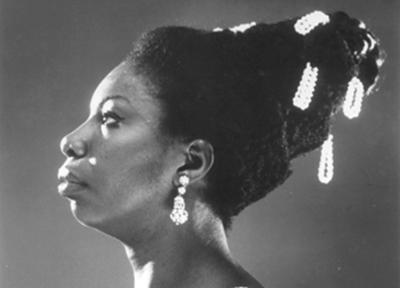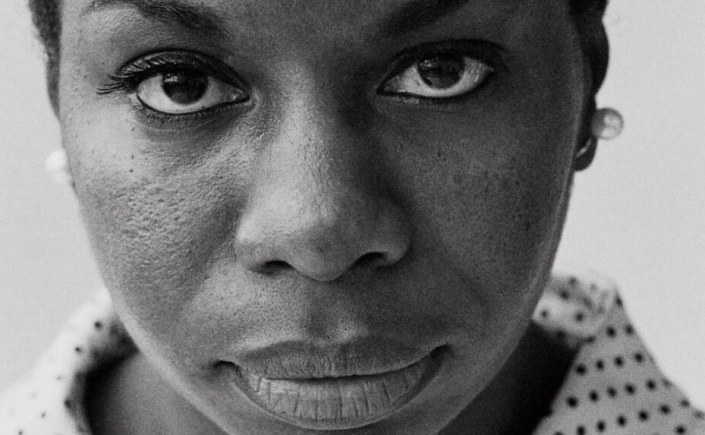The High Priestess of Soul, Nina Simone, was an icon with a commanding stage presence and whose rich contralto voice powerfully wove together stories about liberation, empowerment, and love. She became a voice to power for the black American community. Nina sang from a diverse catalog – jazz, classical, folk, blues, gospel, and covers of contemporary popular artists such as Bob Dylan. She recorded more than 40 albums between 1958 and 1974.

Born Eunice Kathleen Waymon on February 21, 1933, Nina was the sixth of eight children in a poor family. Her mother sang and the family attended weekly church services at the African Methodist Episcopal Church, where her father was a deacon and her mother was Reverend. As young as 2 years old Nina showed that she had an innate talent for music when her parents found her playing the family organ, singing a church hymn entirely from memory.
Nina’s mother also worked as a housekeeper for a wealthy family, the Millers, and she would bring her daughter to work on Saturday mornings. Mrs. Miller went to see Nina playing for a local choir. After hearing Nina’s voice she decided to pay for a year of private lessons with an Englishwoman who Nina called Miss Mazzy. When the year of lessons was completed, everyone agreed they should continue. In order to pay for the lessons, her teacher created the Eunice Waymon Fund for local community members to donate to in support of Nina’s education. In exchange for the town’s kindness Nina agreed to perform regular recitals at a hall in town so that the donors to her fund could hear the progress their young prodigy was making. It was at one of these recitals that
she experienced the reality of racism and prejudice that surrounded her.

When Nina was 10 she played a recital at the town hall for prominent
members of the community. As she was about to perform, Nina’s parents were asked to move to the back of the hall so that a white couple could have their seats. Nina immediately stood up from the piano bench and exclaimed that she would not begin
playing unless her parents remained in their seats.
The fund allowed Nina to enroll in the Allen High School for Girls at age 14. She graduated in 1950 and received a scholarship to Juilliard for one year in preparation for applying to her school of choice – the Curtis Institute in Philadelphia. Nina was devastated when her application was rejected; the school told her it was because “her abilities did not meet their standards of excellence.” Nina and her family and friends suspected the truth was the decision was based on her race.
So she could pay for her own study, Nina worked as an accompanist at Arlene Smith’s vocal studio, taught piano from her home in Philadelphia, and performed at the Midtown Bar & Grill in Atlantic City. She knew her mother would not approve of her playing the “Devil’s Music,” so in 1954, she adopted her stage name. “Nina” was a nickname given to her by a boyfriend and “Simone” was taken from the French actress Simone Signoret. This was when she began to build a loyal local fan base.

Nina signed to her first label, Bethlehem Records. The deal Simone agreed with Bethlehem Records was shortsighted – she signed away her rights to all her early recordings in exchange for $3,000, which cost her upwards of $1,000,000.
In 1958, Nina married Don Ross, but quickly regretted their marriage. It was this same year that she recorded George Gershwin’s “I Loves You, Porgy” (from Porgy and Bess). She had learned of the song from a Billie Holiday album and she first performed it as a favor to a friend. It became her only Billboard top 20 success in the US.
Nina’s debut album Little Girl Blue was released in 1959. She then signed with Colpix Records, who relinquished all creative control to her, including the choice of material that would be recorded. After the release of her live album Nina Simone at Town Hall, Simone became a favorite performer in Greenwich Village. She married he second husband, Andrew Stroud, a New York police detective. He later became her manager and the father of her daughter Lisa. Stroud helped to realize Nina’s dream of playing at Carenegie Hall, but he was also mentally, physically, and sexually abusive.
“She had her own mind. She didn’t give a f— about anybody or anything. She said at one point that I represented strength, and that this is what she liked. And this was her MO. She always looked for security. She was looking for protection.” – Andrew Stroud

Nina Simone with James Baldwin in the 1960s
In 1964, Nina left Colpix and signed with a Dutch label, Philips Records. This changed the content of her recordings. While her music had always drawn upon her African-American heritage, her debut album with Philips, was when her music addressed racial inequality.
In 1965, Nina introduced a song she had written about “four Negro women” – to a young, entirely European white crowd in Holland. Every performance of “Four Women” caught on film (as here) or disk is different.
“Mississippi Goddam” was Nina’s response to the 1963 murder of the civil rights activist Medgar Evers (who had been assassinated by a member of the White Citizens’ Council) as well as the bombing of the 16th Street Baptist Church in Birmingham that same year, which killed four young black girls and partially blinded a fifth. The song came to her “in a rush of fury, hatred and determination” and for Nina, this song was “like throwing ten bullets back at them.” Recorded as a single, it was a pivotal moment for Nina as an artist. The song challenges the belief that race relations can change gradually. It called for more immediate developments – Me and my people are just about due. Not surprisingly, the song caused white tears and was boycotted in some southern states, with promo copies being destroyed by a Carolina radio station.
Nina became increasingly more active and more vocal in the civil rights movement, performing and speaking at meetings and events such as at the Selma to Montgomery marches. Though Nina said in her autobiography that she and her family regarded all races as equal, she openly supported black nationalism and advocated violent revolution. She hoped that African Americans could use armed combat to form a separate state. #BossBitch
“I didn’t like to be put in a box with other jazz singers because my musicianship was totally different, and in its own way superior. It was a racist thing: ‘If she’s black she must be a jazz singer.’It diminished me.” – Nina Simone, I Put A Spell on You (autobiography)

In 1967, changed labels again, moving to RCA Victor. In 1967, she recorded her first RCA album, Nina Simone Sings the Blues which included the song “Backlash Blues” which was written by her friend, Harlem Renaissance leader Langston Hughes. Her second album, Silk & Soul, came out later that year. Nina recorded roughly as many live albums as she made in the studio, and some were a mixture of the two. In 1968 she recorded ‘Nuff Said!, which included live recordings from the Westbury Music Fair of April 7, 1968. This was just three days after the assassination of Martin Luther King Jr. and so she dedicated the performance to him. This album included the song “Ain’t Got No / I’ve Got Life.” This studio recording sets a different tone, a joyous anthem created by merging two songs from the musical Hair. “Like most numbers from Hair, it could easily have been soon forgotten,” wrote Robert Dimery in 1,001 Songs You Must Hear Before You Die. “Its inclusion on the serious-minded ’Nuff Said! is, on the face of it, surprising, but in Simone’s hands the call for freedom takes on a harder-edged civil rights tone, in keeping with the other tracks, while still managing to retain the upbeat mood.” It reached No 2 in the UK singles charts.
Nina protested the Vietnam War by not paying her taxes. When a warrant was issued for her arrest, she fled to Barbados in 1970 to evade the authorities and prosecution. Her abusive husband and manager took this to mean she was divorcing him, but he kept control of all of her finances. While in Barbados she had an affair with Prime Minister Errol Barrow.

Her friend persuaded Nina to go to Liberia, abandoning her daughter during the move. They eventually reunited in Liberia, but, according to Lisa, her mother was physically and mentally abusive. It later came out that Nina was bipolar and she was responding to the on-going and untreated trauma from the violence inflicted on her by her husband.

Nina’s interpretations of existing songs were “so emphatic that other artists would often thieve her version rather than the original performer’s. For his album Wild Is the Wind, David Bowie admitted he was inspired to record a version of the title track after he met Nina in Los Angeles in 1975, while Jeff Buckley’s ” Lilac Wine” slips uncannily into the metre chosen by the singer.”
While”Mississippi Goddamn” has become one of her best-known protest songs, Nina has said it harmed her career. She blamed the industry for boycotting her music which led to a decline in recordings, sales, and her popularity. In an interview with the BBC, Nina tells how she shot at a music industry executive and she spoke about the corruption of the industry.
It wasn’t until 1987, when her song “My Baby Just Cares for Me” became popular in Europe. When it was featured in a commercial, Nina’s amazing voice and talent became popular once more. “Feeling Good” was another song that was featured in a commercial in the 1980s, adding to her renewed popularity. It has been sampled by many hip-hop artisits, including Kanye West for “New Day” on the Watch the Throne album with Jay Z.
A movie about Nina came out in 2016, with many critics calling attention to the chosen actress, Zoey Saldana, a black and Latina actress with a much lighter skin tone than the woman she was portraying. Saldana initially hesitated to accept the role saying “I didn’t think I was right for the part, and I know a lot of people will agree.” But she changed her tune. “An artist is colorless, genderless… It’s more complex than just ‘Oh, you chose the Halle Berry look-alike to play a dark, strikingly beautiful, iconic black woman.’ The truth is, they chose an artist who was willing to sacrifice herself. We needed to tell her story because she deserves it.” What Zoey failed to understand is that Nina Simone is not colorless or genderless. Her identity was a driving force behind her activism. And, yes, Nina’s story needs to be told – but it needs to be her story.
The National Trust for Historic Preservation (with support from the Ford Foundation and the African American Cultural Heritage Action Fund) announced that Nina’s childhood home will be protected as a National Treasure – the first musical site to be protected.
Nina was the recipient of a Grammy Hall of Fame Award in 2000 for her interpretation of “I Loves You, Porgy.” On Human Kindness Day 1974 in Washington, D.C., more than 10,000 people paid tribute to Simone. Nina received two honorary degrees in music and humanities, from Amherst College and Malcolm X College. She was inducted into the Rock and Roll Hall of Fame in 2018.

